POST IN THE CHAT!
What is one technology from the future that you wish you had today? Why?
Regional Broadband American Rescue Plan Conversation
Meeting II In Series of Regional Boradband Conversations
Meeting 6/30/21

Agenda
Welcome and Communications Update
Community Exchange Waterfall
ARPA Funding Breakdown
Principles for ARPA Spending
Digital Access Issues Explained

Potential ARPA Funded Uses
Meeting Goals

Clarify ARPA guidance regarding use for digital access / broadband
Outline principles and potential vehicles for ARPA spending

Organize stakeholder priorities as related to digital access and broadband
MAPC'sGoals

Support municipalities in acheiving their goals related to Digital Access
Advocating for State resources that will support municipal and community efforts to close the digital divide.

Developing purchasing vehicles for collective uses.
Communications Update:
Regional Digital Access Slack Channel
MAPC can provide a guest Slack account for use.
- Post updates, articles, data sources, insights.
- Allow for cross organizational sharing and coordination.
- Save inboxes and allow for ongoing conversations
Guidelines for the Slack Channel
- Be respectful
- Acknowledge different backgrounds and levels of familiarity with topic
- No pressure to participate!

Community Exchange Waterfall
POST IN THE CHAT!
Update on Digital Access work
Question for MAPC or others on the call regarding Digital Access or ARPA
American Rescue Plan Funding Breakdown
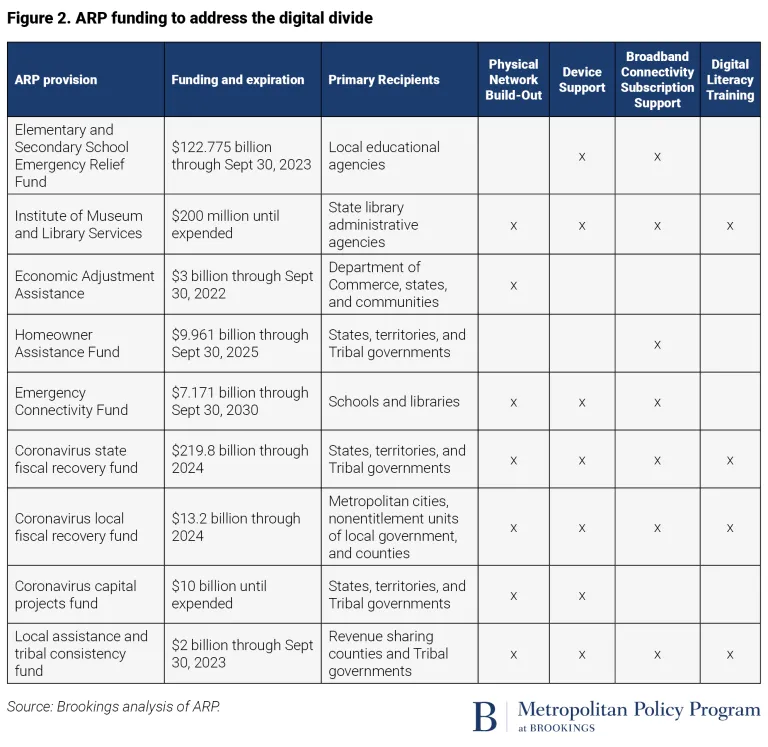
ARP Allocations
Source: Brookings Institute
https://www.brookings.edu/research/the-american-rescue-plan-is-the-broadband-down-payment-the-country-needs/
ARP Guidance:
State and Local Allocations
- Support public health expenditures, by, funding COVID-19 mitigation efforts, medical expenses, and certain public health and safety staff
- Address negative economic impacts caused by the public health emergency, including economic harms to workers, households, small businesses, impacted industries, and the public sector
- Replace lost public sector revenue, using this funding to provide government services to the extent of the reduction in revenue experienced due to the pandemic
- Provide premium pay for essential workers, offering additional support to those who have and will bear the greatest health risks because of their service in critical infrastructure sector
- Invest in water, sewer, and broadband infrastructure, making necessary investments to improve access to clean drinking water, support vital wastewater and stormwater infrastructure, and to expand access to broadband internet
ARP Guidance:
State and Local Allocations
Broadband Infrastructure Guidance
"Infrastructure investments in areas that lack wireline connection that reliably delivers 25/3 service"
"Prioritize middle mile and last mile connections"
"Prioritize projects that use modern technology delivering 100/100 service"
"Recipients are encouraged to pursue fiber optic investments"
Demonstate COVID Impact
Source: US Treasury Fact Sheet, 5/10/21
https://home.treasury.gov/system/files/136/SLFRP-Fact-Sheet-FINAL1-508A.pdf
ARP Guidance:
State and Local Allocations
Broadband Infrastructure Guidance - "Reliably"
"Treasury’s Interim Final Rule provides that investments in broadband be made in areas that are currently unserved or underserved... lacking a wireline connection that reliably delivers minimum speeds of 25 Mbps download and 3 Mbps upload"
"The use of “reliably” ... provides recipients with significant discretion to assess whether the households and businesses have access to wireline broadband service that can actually and consistently meet the thresholds of at least 25Mbps/3Mbps—i.e., to consider the actual experience of current wireline broadband customers. Whether there is a provider serving the area that claims to offer speeds that meet the 25 Mbps download and 3 Mbps upload speed thresholds is not dispositive"
ARP Guidance:
State and Local Allocations
Digital Divide
"In view of the wide disparities in broadband access, assistance to households to support internet access or digital literacy is an eligible use to respond to the public health and negative economic impacts of the pandemic, as detailed above."
"Recipients may use funds to provide assistance to households facing negative economic impacts due to Covid-19, including digital literacy training and other programs that promote access to the Internet."
ARP Guidance:
State and Local Allocations
Cybersecurity
"Recipients may also use funds for modernization of cybersecurity, including hardware, software, and protection of critical infrastructure, as part of provision of government services up to the amount of revenue lost due to the public health emergency."
ARP Summary

Infrastructure investments in areas that are underserved by reliable high speed internet.
Cybersecurity
Offset Tax Reduction
Pensions
Debt Service
Digital literacy and connectivity programs





Stabilization Funds


Other demonstrate disproportionate COVID impact

Guiding Principles for State and Local Government
DRAFT Principles for Local Government
Remove affordability and adoption barriers that prevent universal access to reliable and high speed internet.




Ensure all residents who desire to improve their digital / technology literacy have a pathway to educational opportunities at a range of skill levels, offered in community appropriate languages and settings.
Augment the capacity of key stakeholders such as IT Departments, School Districts, Libraries, Community based organizations, and municipal staff to address the digital divide
Promote competition among internet service providers offering broadband service.
Recognize the importance of proactively investing in cybersecurity measures.


DRAFT Principles for State Government
Augment ARPA funds made available to municipalities for those municipalities who have been hit hardest by COVID (health and unemployment) and likely have competing needs for funds in other areas that may outweigh digital divide issues.

Build the nascent capacity of local government and community groups in the area of the digital divide and digital infrastructure.
Catalyze additional investment by municipalities and private sector actors to improve affordability, reliability, and speed of the internet; as well as market competition for broadband service.
Future Investments
Federal Transportation Bill

Federal Broadband Bill
State IT Bond Bill
Various Federal Grants under NTIA
Diagnosing the Problem

Three Determining Factors of Digital Access



Connection
Adequate Device
Literacy
Fast
Affordable
Router
Personal Computer /Laptop
Use of Technology
Ensuring functioning equipment
Evaluating quality of information and privacy risks

Connection in Chelsea & Revere
Is it Fast?
40 – 50%
of households in Chelsea and Revere with internet access do not have "broadband" speeds

Speed Sources: MLab, Microsoft US Broadband Usage, Demographic Source: US Census ACS 5 Year, 2019
"I live in a 40 unit mid-rise and am told by the internet provider that most of the issues are because the wiring in the building is old. The provider says it's not their problem. We have interruptions all the time, no notice, residents just start calling each other to see if they have wi-fi. Could be down for hours. I work from home and it's a real issue for me."
Is it Reliable?

Connection in Chelsea & Revere
~6,104 (19%)
Chelsea / Revere households lack internet service.
~40%
of survey respondents do not believe their internet service is affordable.
72%
of survey respondents have had to cancel or change their internet subscription because it is too expensive

Is it Affordable?
Sources: US Census ACS 5 Year, 2019.
MAPC Community Digital Needs Assessment 2021
"Necesitamos que el costo del internet sea mas justo
-
We need the cost of the internet to be fairer"
Device Access in Chelsea & Revere
How accessible are devices?
12%
of Chelsea & Revere households have no computing device at all
23%
of survey respondents disagree with "People in my household always have access to a computer if needed."
About 60%
of Chelsea / Revere households with internet lease a router from their service provider

Are routers adequate?

Device Source, Computers: US Census ACS 5 Year, 2019. Device Source, Routers: MAPC Survey - 6/29/21
"Our internet speed greatly improved after we bought our own router; the routers provided by Comcast don't seem to be very good"
Literacy in Chelsea & Revere
Using Technology
~75%
of survey respondents agree with "I feel confident in my ability to use a computer/laptop/Chromebook
~50%
of survey respondents agree with "I feel confident that I am able to resolve issues related to my internet connection"

Ensuring Functioning Equipment

Evaluating Information and Privacy Risks
Anecdotal information gleaned from stakeholder conversations indicates that there are serious concerns related to privacy, particularly among the immigrant population
Source: MAPC Survey - 5/26/21
Internet Subsidies
~500,000
families in Massachusetts are eligible for Internet Essentials and the Emergency Broadband benefit fund
Comcast Internet Essentials Plan offers basic internet service for $10 / Month to income eligible households (SNAP, Free or Reduced Lunch, etc)
The Emergency Broadband Benefit program will subsidize $50 for all Comcast service plans - as of June 29th only 30,000 households in the s
Only 30,000
households have taken advantage of EBB since May 16 2021
Source: Universal Services Administrative Co, National Center for Education Statistics, MAPC Digital Access Survey 6/29/2021
"سمعت بأن شركة كومكاست توفر انترنت مجاني لأصحاب الدخل المحدود .هل هذا صحيح؟
-
I heard that Comcast company provides free internet to people with limited income. Is this true?"
Why is it this way?
The cable infrastructure at the household level is likely impacting service and reliability.
A lack of competition, shrinking cable service revenues, and a lower income service area are likely disincentives for investment from the private sector.
At the household level, individuals are likely using outdated or ineffective routers and devices.
Internet subscribers may not have the confidence or technical skills to trouble shoot internet speed or function issues.
Larger households who may need faster speed packages may be cost burdened and unable to afford those plans.
Individuals who are eligible for subsidized services may not be taking advantage of them due to a lack of information, trust, stable housing, documentation, or other structural and social factors.
Potential ARPA Funded Uses
Starting Practices
- Quantify the issue and understand the needs
- Coordinate stakeholders
- Guide decision making
- Better understanding current public assets that could be leveraged (fiber, rooftops infrastructure, etc.)
Develop a Digital Equity and Access Plan
Digital Equity Trust Fund to Purchase PC's, Routers, and Bulk Internet Subscriptions
Examples
Examples
Plans w/ MAPC underway in Everett, Revere & Chelsea

Library / School Device Lending Programs
- Develop funding pool to invest in community initiatives
- Make devices available through programs at libraries & schools
- Support computer purchasing or refurbishment programs

Digital Navigators / Digital Stewards
Digital Navigators
Digital Stewards
- Different from Navigators, Digital Stewards are community members who receive advanced training in internet network technology.
- They are able to support community-focused WiFi programs that support free and open internet networks.
- Individuals who address the whole digital inclusion process — home connectivity, devices, and digital skills
- Navigators can be volunteers or cross-trained staff who already work in social service agencies, libraries, health, and more who offer remote and socially distant in-person guidance. Can help support the critical issue of adoption as well as access.
Examples
NDIA w/ Salt Lake City Library
Providence w/ Digital Promise
Connecticut State Library
Examples
Southern Connected Communities
New York Digital Stewards
Open WiFi
Affordable Housing Open Networks
Community Mesh Networks
Examples
ESH in Oakland
ESH w/ NPower Baltimore
Olneyville Providence w/ One Neighborhood Builders
- Utilize commercial or municipal internet networks to access high-speed wireless signals via a rooftop receiver.
- Make wifi access default. Leverage common spaces and broadcast on an open access router system for in-unit access.
Examples

The People's Network Helium Routers
- A distributed system of routers and devices that work in concert to provide internet access to users within a given geography, owned and managed by the community.
- Explore revenue-generating equipment like Soofa Signs and Helium Routers
Infrastructure Upgrades
Pull Fiber to Buildings and Retrofit Coaxial
Expand Municipal Fiber Infrastructure

ISP Fiber is typically limited to privately owned infrastructure. Bringing fiber closer to the end user by pulling it into buildings will improve speed and reliability of service (although may not impact price without other strategies).
Municipal fiber has traditionally been limited to a loop that connects public buildings like schools, town hall, and libraries. Expanding municipal fiber, or at least conduit can serve to open new options for public and commercial connectivity.
Fiber Retrofits
Examples
Cambridge MA
Expanded Municipal Infrastructure
Increased Competition & Infrastructure Options
Open Access Networks
Partnerships with ISPs

Examples
Examples
- Ownership does not mean Internet Service Provider
- Different models exist some connect to residences, other connect anchor institutions like municipal networks and high education.
- An opportunity that expands municipal fiber infrastructure, but does not require the municipality become the service provider.
- Partnering with Public or Private Equity to bringing fiber closer to the end-user by pulling it into buildings
- Retrofitting buildings with outdated wiring
- Leverage cable franchise agreement
- RFP for use of assets like rooftops
- Qualifying residents based on need, removing the administrative burden from resident and companies.
Accessing the Internet Using Cable

Data Center


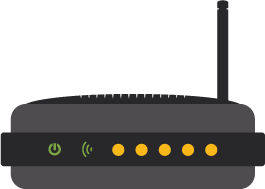



Fiber (Fast)

Cable (slower)

Cable (slower)
Wifi (slower) or ethernet (more reliable)
Slows down every step
The farther fiber optic cables go, the faster the internet
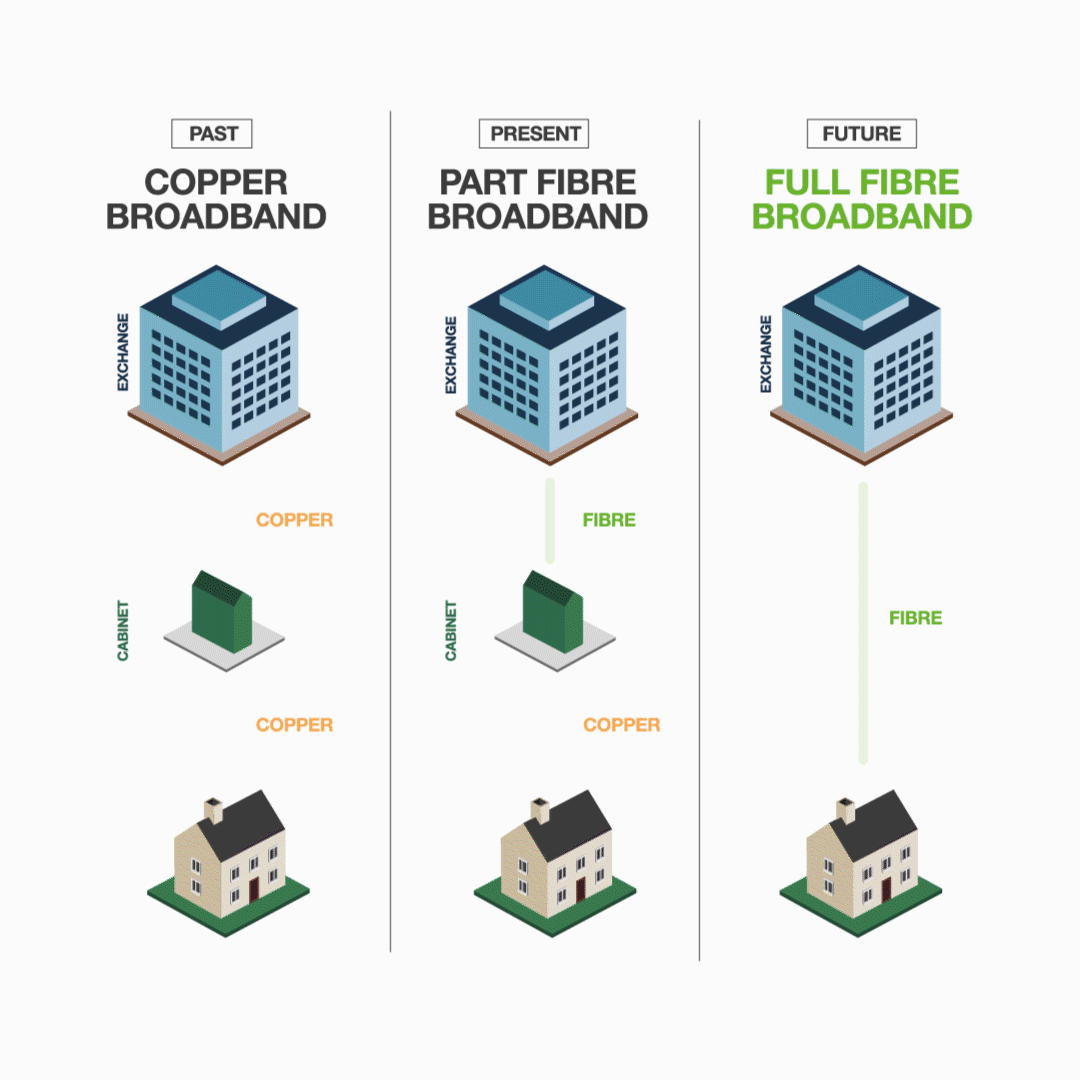
Copper wire slows the connection
Household size further complicates things
Survey question:
How often does more than one person need to be on the Internet at the same time?
~83%
Frequently or Always
Survey question:
Have you ever had to change or cancel your internet subscription because it was too expensive?
~76%
Spanish Respondents, Yes
Source: MAPC Survey - 5/26/21
~66%
English Respondents, Yes
Preference for local support
Survey question:
I would prefer to have a local resource that could support my technology needs, rather than relying on internet service providers.
~96%
Spanish Respondents, Yes
Source: MAPC Survey - 5/26/21
~86%
English Respondents, Yes
Cable Providers in Everett
Comcast
RCN
Incumbent Cable Franchise, Full Coverage in Everett
In 2011 Comcast had 10,603 Cable TV Subscribers.
In 2020 it had only 7,000
Source: Mass DTC Form 500, 2011 - 2020
Competitive Cable Franchise, Limited Coverage in Everett
In 2017 RCN had 2,171 Cable TV Subscribers.
In 2020 it had only 957
Household size further complicates things
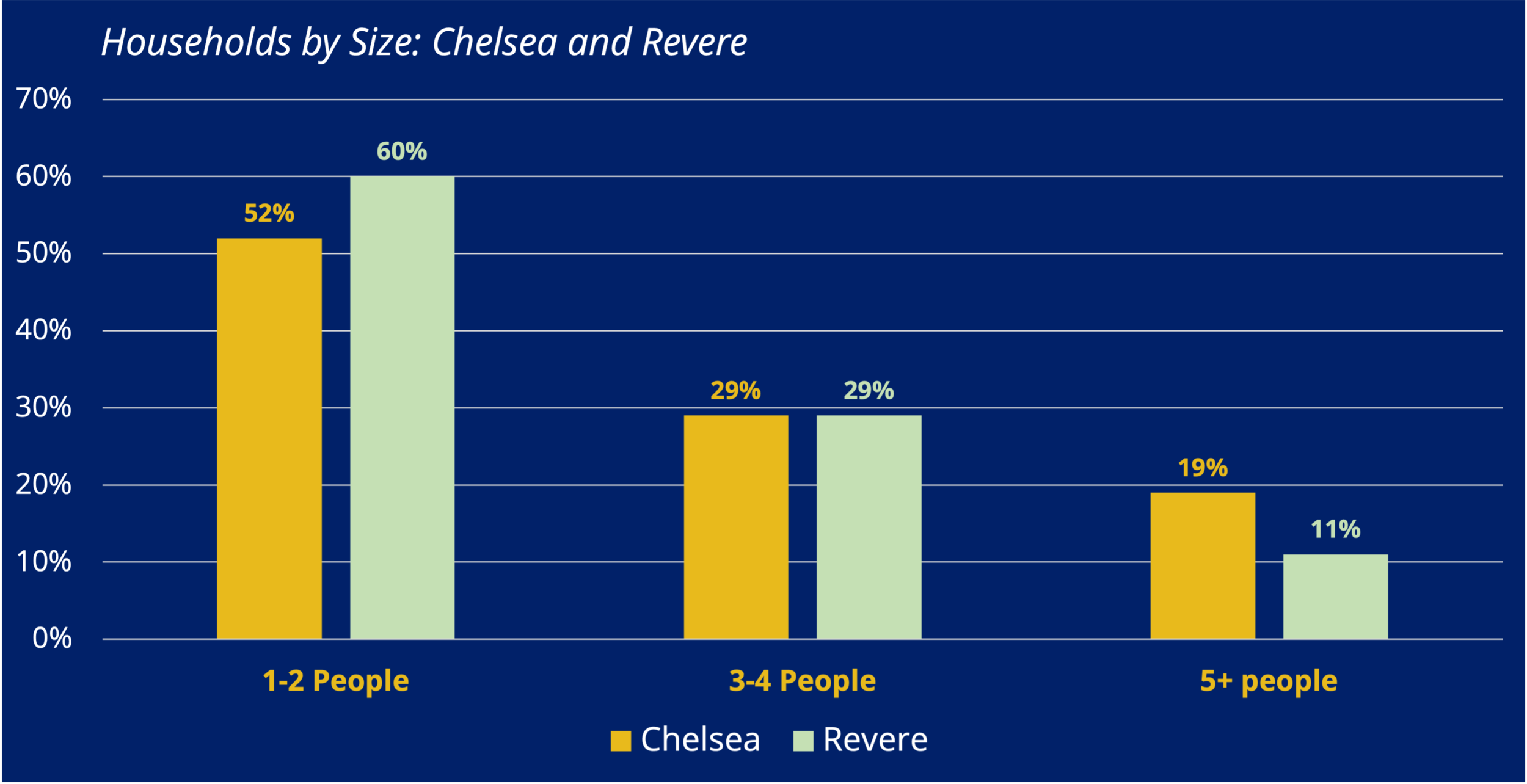
For 1-2 people, internet should be at least 25-50 Mbps
$10-$30 per month
For 3-4 people, internet should be at least 50-100 Mbps
$35-$50 per month
For 5+ people, internet should be at least 200-500 Mbps
$50-$70 per month
Source: US Census ACS 2019 5 Year, AllConnect
Legacy of Cable
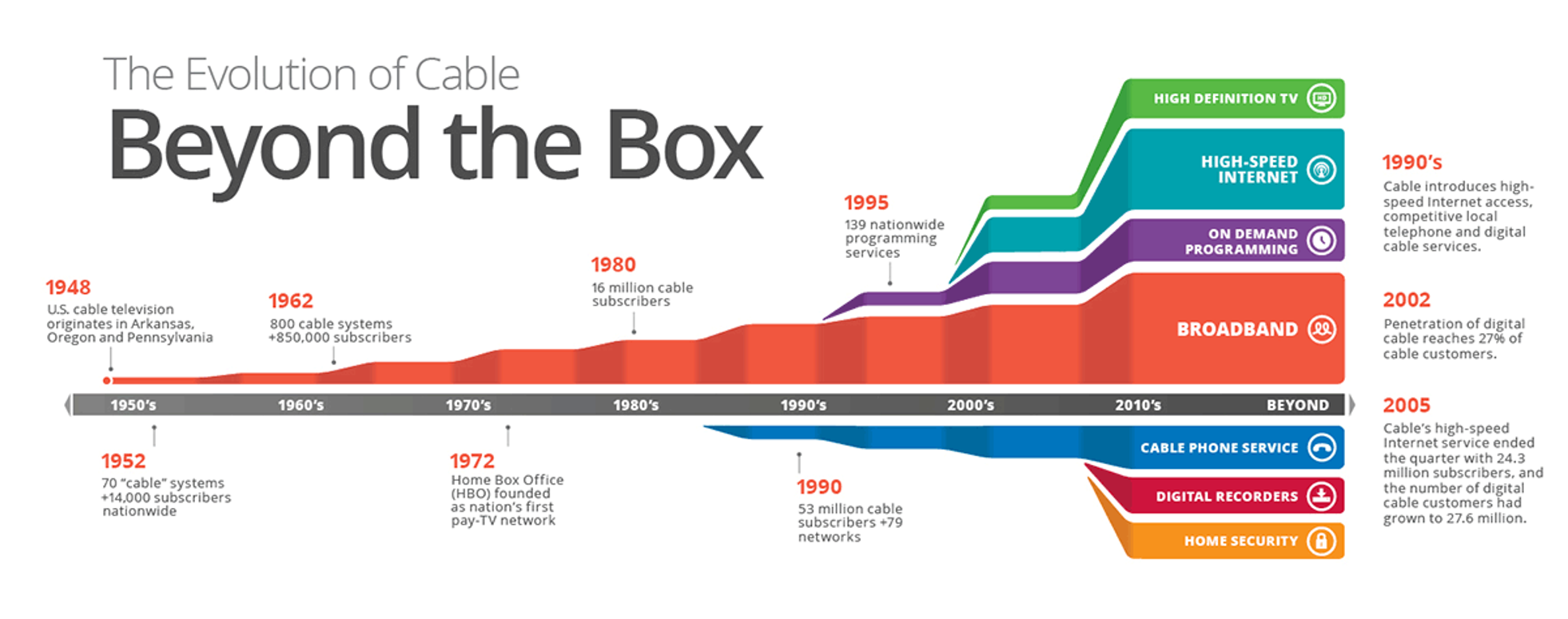
Image Source: https://calcable.org/learn/history-of-cable/
Where is the data?

Percent of Households without Internet Access

Percentage of Households without an Internet Subscription
15.8% of Everett households lack internet service.
38% of Everett households earning less than $20,000 per year lack internet service.
12% of Everett households rely on smartphones for internet service
One-third of the households with internet access do not have "broadband" speeds



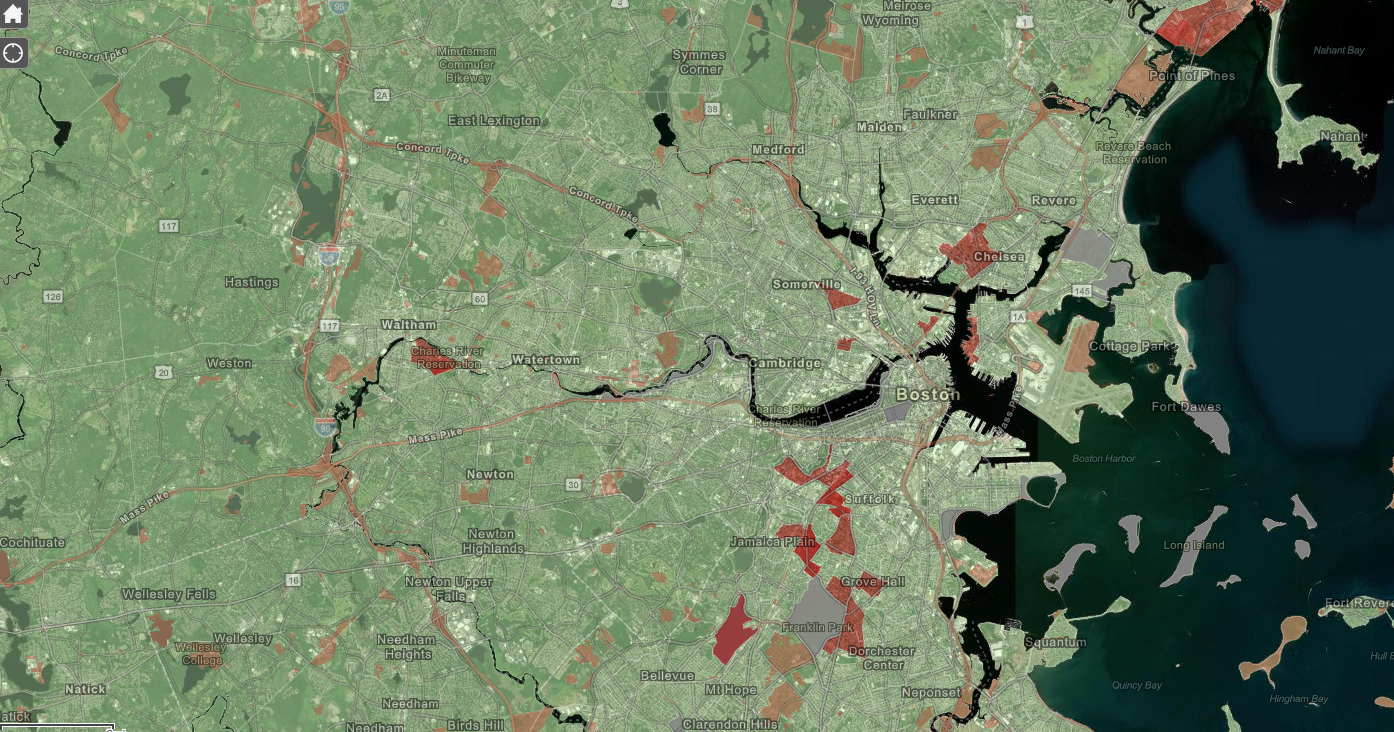
The Indicators of Broadband Need map was created by the United States Department of Commerce, National Telecommunications and Information Administration (NTIA).
The map uses several different data sources to show information on broadband availability within the United States.
Layers in this map were created using data sourced from the American Community Survey collected by the U.S. Census, Measurement Lab (M-Lab), Ookla, Microsoft and the Federal Communications Commission (FCC).
https://broadbandusa.maps.arcgis.com/apps/webappviewer/index.html?id=ba2dcd585f5e43cba41b7c1ebf2a43d0
GeoTel
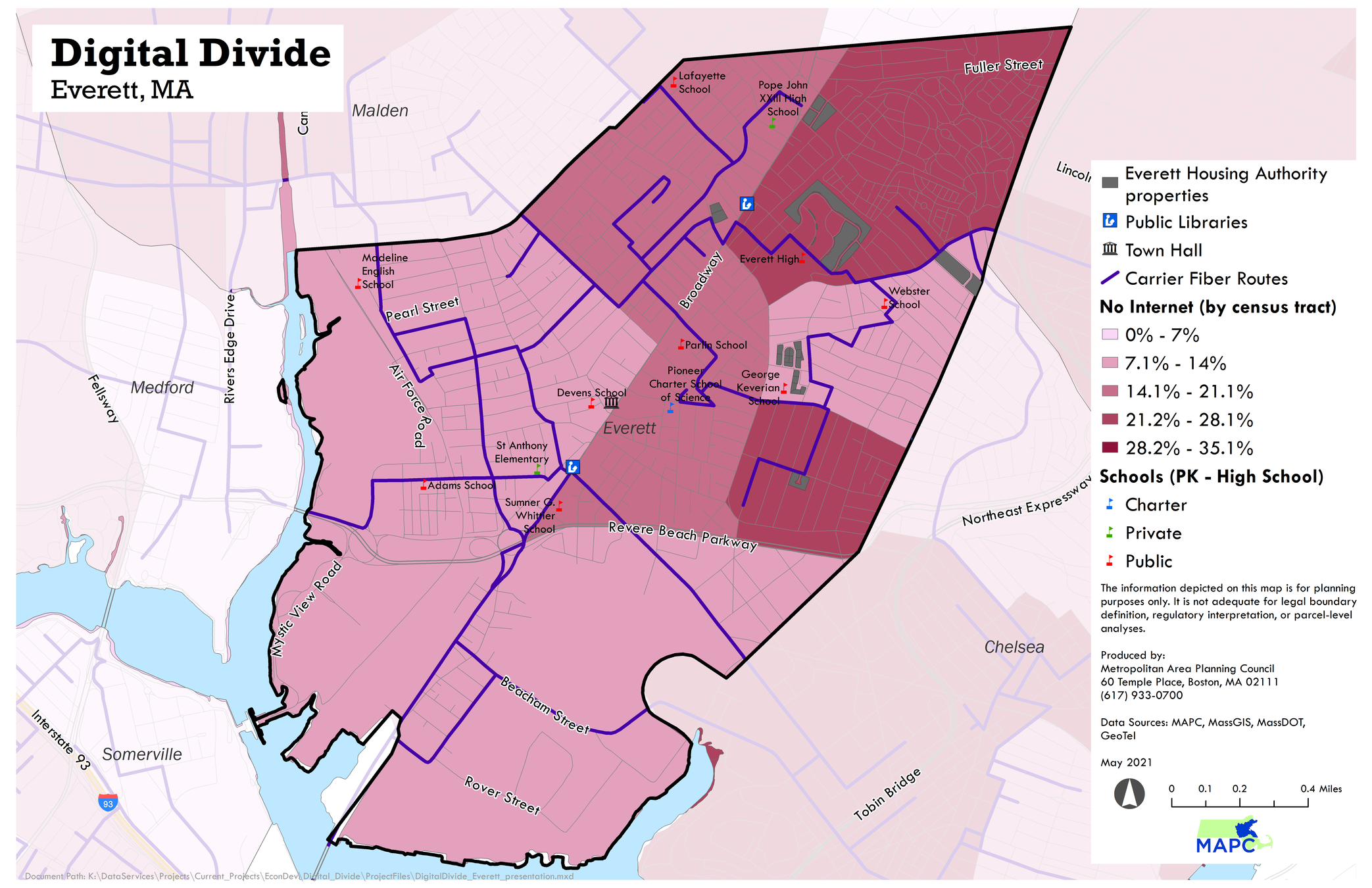
Additional Areas of Work
MBI Gateway City WiFi Grant
- Deploying $500k in funding to install WiFi systems in Chelsea, Everett, Revere, Quincy and Malden
-
Facilitating a regional discussion related to ARPA priorities among municipal, state, and non profit stakeholders
Regional Coordination
Please reach out to Josh Eichen! jeichen@mapc.org
- Working with the MassHire system to develop a digital navigators model using YouthWorks program funds.
Digital Navigators Development
Digital Justice Principles: Access
- Digital justice ensures that all members of our community have equal access to media and technology, as producers as well as consumers.
- Digital justice provides multiple layers of communications infrastructure in order to ensure that every member of the community has access to lifesaving emergency information.
- Digital justice values all different languages, dialects and forms of communication.
Source: Allied Media, Teaching Community Technology Handbook
Who's Job is it to Solve the Digital Divide?

Planners
Libraries
School Districts
IT Directors
Housing Authorities
Healthcare Providers
Workforce Boards
Community Based Organizations
Elected Officials
Private Sector
The State???

What Are the Answers?

Funding Opportunities
Mass Broadband Institute Gateway City WiFi Grant Program
- Up to $100,000 in grant funds to support new WiFi installations in Everett.
- Public Housing/Affordable Housing
- Downtown: Where else?
-
American Rescue Plan Package
- ~1.2B Deployed to Communities in MAPC Region
- ~$5.4B available to the Commonwealth
- Broadband Infrastructure, Digital Literacy, and Digital Access are all eligible uses of funding
The Interim Final Rule gives recipients broad latitude to use funds for the provision of government services to the extent of reduction in revenue. The calculation of lost revenue begins with the recipient’s revenue in the last full fiscal year prior to the COVID-19 public health emergency and includes the 12-month period ending December 31, 2020. However, use of funds for government services must be forward looking for costs incurred by the recipient after March 3, 2021